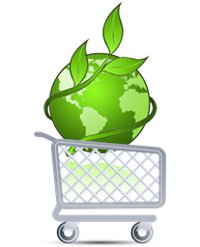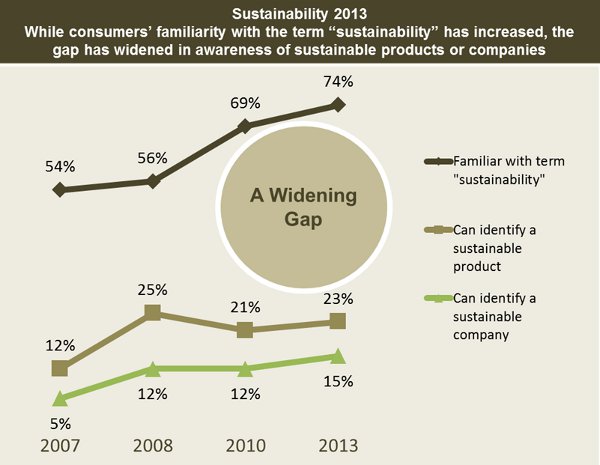The sustainability gap widens: consumers still not buying into sustainability at store shelves

If you thought all the media coverage swirling for years around sustainability would have helped to raise consumer awareness for the term (at least a little), well, you'd be right. That's the upside. The downside, unfortunately for companies hoping to cash in on sustainability, is that increased awareness has not translated well to increased purchase activity at store shelves of products or brands with any sort of a sustainability halo. Why aren't consumers putting their money where their sustainable aspirations are? The answer lies somewhere in the widening gap between familiarity with the term "sustainability" and consumers' ability to identify sustainable products or companies.
It turns out that much of the consumer framework of "sustainable companies" derives from media coverage on those companies in which social, economic, and environmental practices and initiatives are considered exemplary. Hershey's cuts water consumption in its facilities by 58 percent, Walmart commits to a goal of being supplied 100 percent by renewable energy by 2020, or Patagonia launches a new $20 million green venture capital fund: these are examples of stories that resonate with consumers, albeit Core consumers in the World of Sustainability are the most likely to read them with the greatest scrutiny.
These are noble pursuits, for sure. Yet (and this is a big, expensive "yet" for companies developing brands beneath a sustainability halo) CSR-influenced awareness among consumers rarely translates into purchase conviction at the shelf.
The Hartman Group's recently released Sustainability 2013: When Personal Aspiration and Behavior Diverge report finds that consumers are more familiar with the term "sustainability" than they are able to identify sustainable products, and they are also more able to identify sustainable products than companies. As the following chart depicts, the gulf between awareness of the term and familiarity with sustainable products or companies has increased over time.
Source: Sustainability 2013: When Personal Aspirations and Behavior Diverge, The Hartman Group, Inc.
Addressing the Gap, Understanding the Barriers
In the World of Sustainability, there is a widening chasm between what consumers say they want and what they actually buy. On the one hand, consumers say they want to be sustainable and they want companies to behave sustainably. On the other hand, when companies do take action, consumers don't always give them the credit they might expect. There are mechanisms underlying why consumers don't always prioritize sustainability in their purchase behavior.
In the past, much of the focus has been on consumers' perceptions of sustainability at company level. Our research finds that this does not adequately explain why companies are not rewarded for their sustainable practices and positioning.
To better understand and address ways to bridge the gap, we believe it is necessary to focus on sustainability at the category level, rather than the company level. Why the category level?
Even though consumers want to be sustainable, sustainability takes a backseat to the other concerns consumers have in their personal lives. Even for those consumers more evolved in the World of Sustainability, it is often too complicated for them to weigh up every dimension of responsibility for every portion of the product cycle for every product they buy. While consumers want to make sustainable purchases, they also want the decision-making process to be less complex.
As such, consumers use shortcuts to help them prioritize which dimensions are the most important and which they buy. How they prioritize depends on three interrelated components underlying the gap:
- Knowledge. What they know about most (i.e., what issues are most salient in the media in their discussions with their friends)
- Practicality. What also helps them practically (i.e., most clearly ladders up to the Personal Benefit Zone by offering quality, great experience, health, safety, efficacy, convenience)
- Faith. The issues they have connection with, most compellingly with their values, and have most faith in can make a difference
Category-level sustainability analyses enable us to determine what elements of personal, social, environmental, and economic benefits consumers apply to different types of products. These vary substantially within food and beverage, personal care, pet products, food service, and retail sectors, all of which are examined in our Sustainability 2013 report.
For brands to succeed in bridging the gap between green attitudes and buying behavior, they will need to address barriers voiced by consumers centered on Knowledge, Practicality, and Faith:
- Knowledge. Speak to concepts consumers already know and understand rather than trying to educate them about new and complex ideas.
- Practicality. Make it easy for consumers to prioritize Sustainability by maximizing the personal benefits of sustainable products.
- Faith. Show consumers that they're really making a difference.
For the greatest impact, communicate sustainability in a way that is relevant and moving for your category and products. This is a topic for an upcoming hartbeat article where we'll give some category-specific examples.

